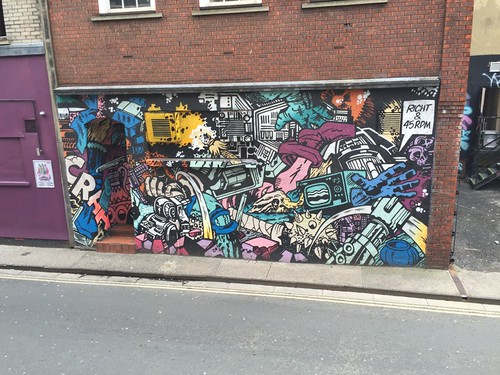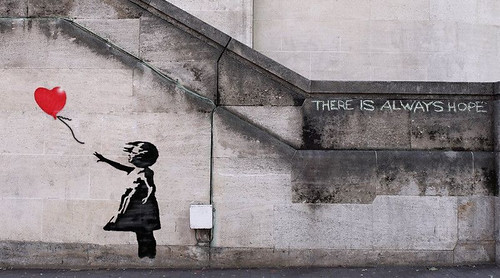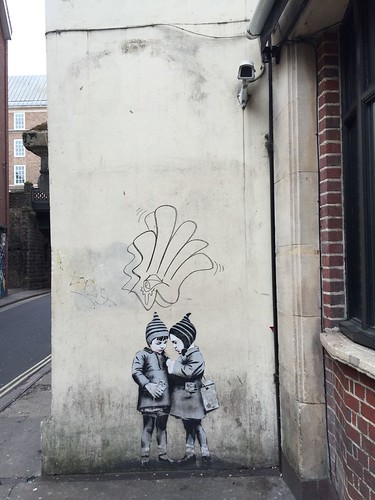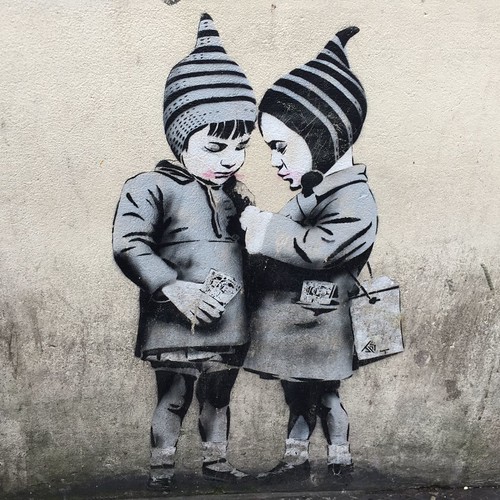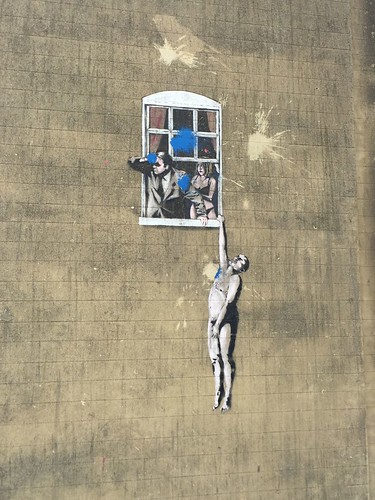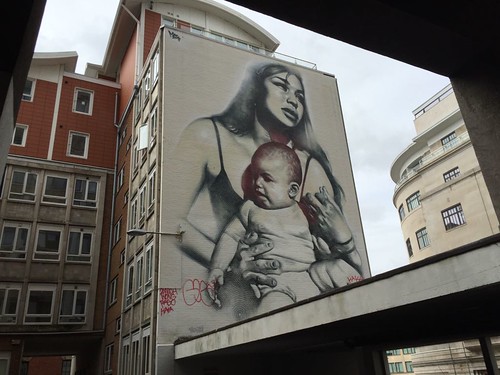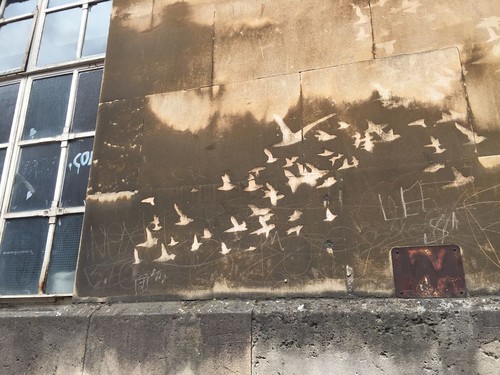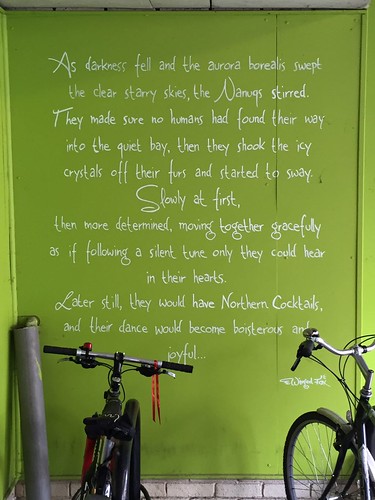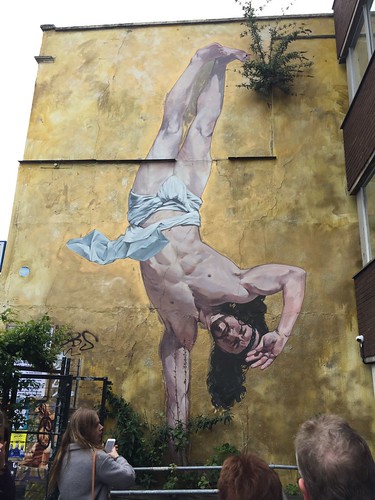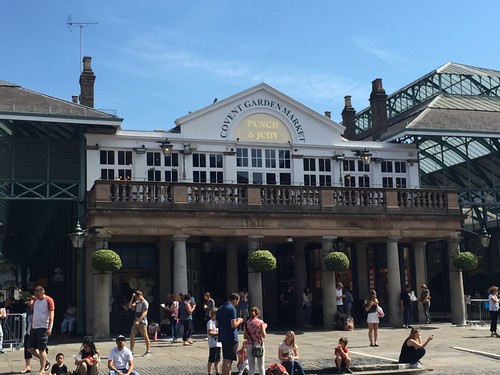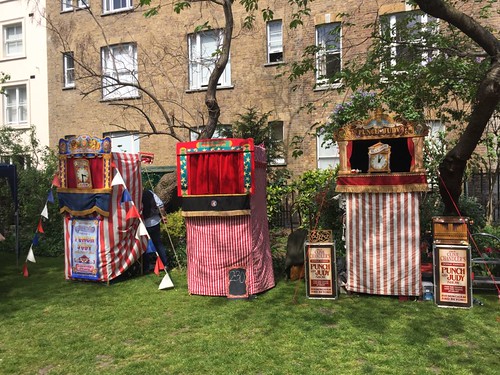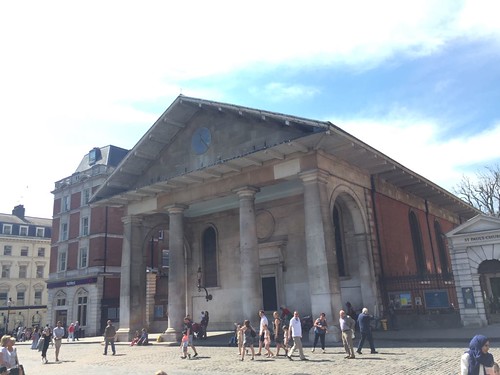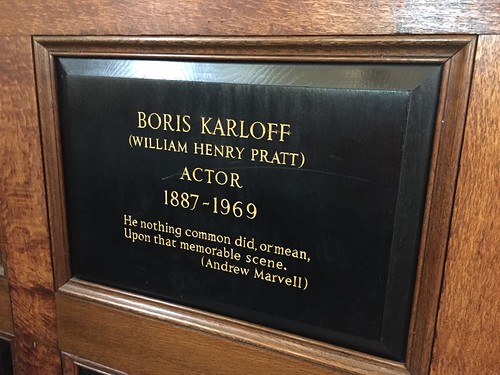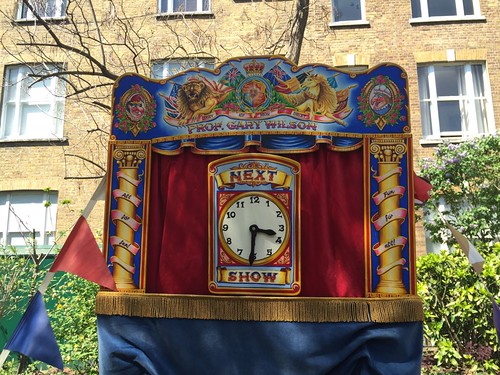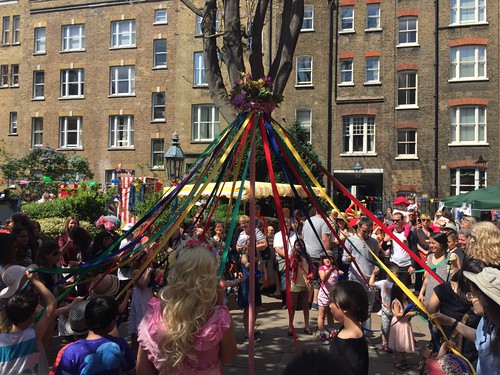I bet you thought you were finished hearing me go on about Bristol, right? Ha! How wrong you were. How many more wonders of Victorian engineering can I tell you about? How many soaring bridges? How many big, greasy gears? How many ground-breaking maritime propellor designs? None. That’s how many. No more Victorians. Today, we’re rocketing into the very modern world of street art.
"Street Art?”, you say, "Isn’t that just an apologetic, politically correct term for good old fashioned graffiti?” Sort of, yes. Technically, street art is a subset of graffiti. Because technically, graffiti is "writing or drawings that have been scribbled, scratched, or painted illicitly on a wall or other surface”. (Thank you, once again, Wikipedia.) (And yes, I’m aware that technically, graffiti is plural and so that last sentence really should have been “graffiti ARE” not "graffiti IS” but that would make me sound like even more of an insufferable pedant than usual.) Opponents might sniffily dismiss street art as unwelcome and destructive, but fans would say it's public art, albeit usually (though not always) unsanctioned. And Astute Go Stay Work Play Readers will recall we’ve already seen some particularly charming examples of Paris street art from a much earlier Day Out.
As it turns out, Bristol is a hotbed of street art, thanks largely to the most famous street artist in the world, Banksy. Banksy is the nom de plume of an anonymous Bristol-based artist and political activist whose freehand creations first appeared on Bristol walls starting 1990. What’s he’s best know for, though, are his now-iconic stencilled works on anti-establishment themes. And yes, I said anonymous. Despite the fact that he’s now internationally renowned and his work sells for considerable sums, his true identity is still unverified. (Yeah, yeah, people mostly kinda think they’ve figured things out, but let’s not spoil it. )
Banksy may be Bristol’s most famous street artist (by a long chalk) but he is certainly not the only one. Which is why, after a Saturday full of Victorian boats and bridges, I decided to spend my Sunday morning on a guided tour of the ever-changing display of Bristol’s Street Art. The tour started at College Green in the city’s centre, which is also the city of Bristol City Hall. Our guide was herself an artist, and she started by talking a little about the scene in Bristol and about the nature of street art. I guess it’s a particular challenge guiding this kind of tour because street art can be a highly transient medium. The guide admitted she’s constantly scouting and having to revise the tour route to take in new works and bypass old ones that have been painted over or tagged beyond recognition.
Street art comes in many forms. Most people will immediately think of the colourful freehand spray painted murals that show up on walls and hoardings. Spray paint’s big advantage is that it’s fast and easy to transport. It also dries very quickly, which allows you to layer over it and build up complex work in a short amount of time, and that can be important if you’re working on the edge of legality.
But freehand spraying is just one form of street art. At the bottom of the hierarchy is tagging, which I’d say doesn’t really constitute art at all. To give you an analogy, tagging is to street art as living statues are to opera. Or possibly as balloon folding is to the symphony. Tagging is that annoying signature-like thing that’s usually done simply with thick felt-tipped markers or spray paint. Taggers each have a particular design for their tags that they repeat over and over.
The Big Deal is a good example of stencilling, including different colours and probably some added brushwork and spraying. This kind of mixed media can be common. Here’s a quite famous Banksy that we saw at the start of our tour. It’s located right across the street from Bristol City Hall, and is a bit of a taunt to the council authorities who removed a previous Banksy work showing a scuba diver pulling a giant bath plug out of the fountain in front of city hall. (A lot of Banksy’s stuff makes very clever reference to existing architecture or textures in the wall surface.)
Stencils have the advantage of allowing an artist to carefully plan a work in advance - some stencils are even laser cut which allows for great detail. And stencilling means a complex piece can be executed quite quickly on site. Some artists, though, go for the old faithful paint brush. It’s a much slower method, but allows for more precision than spraying (even with a stencil). Quickest of all, though, is a paste-up, which is precisely what it sounds like - a pre-printed piece of paper or set of papers that’s simply pasted onto the wall. More complex paste-ups can even be 3D, sort of like the Paris Space Invaders.
Bristol’s street art scene is established enough that they even held a sanctioned festival in 2011. Specific buildings were identified, high-angle access equipment hired, and international artists flown in from around the globe. Our guide showed us several of the giant artworks that were part of the festival, and the most astonishing thing for me was that they were buildings I’d walked past the day before, utterly obliviously. If I’d simply turned my face up I might have seen this:
And once my eyes had been opened, I could see that Bristol is frankly blanketed in street art. Giant murals, tiny paste-ups, witty stencils, and endless tags. I was particularly taken with a clever sort of stencilling on an old and dirty stone council building. Rather than painting on top of the stone, the artist created a stencil and pressure-washed his design so that he was, technically, not actually applying anything to the wall.
We finished our tour in the neighbourhood of Stokes Croft, which has a reputation for being a rough neighbourhood. But the building where we ended - Hamilton House - is clearly helping to turn that around. The building houses artists’ studios, festival offices, radio stations, film and music producers, alternative therapists, dance groups and social enterprises of all stripes. There’s also a café on the ground floor, and that’s where we saw the last works in the tour. Our guide has a studio in the building and she showed us a commissioned work she’d done that I found just lovely.
A few local guys were sitting in the outdoor seating area of the café, one of them wearing a Dismaland hoodie. They bantered with us a bit, clearly aware of why we were there, and implying that one of them might be Banksy himself. But the whole exchange was tinged with a bitter note that made you think these guys must be very tired of their neighbourhood and community being on display for passing rubberneckers. This, coupled with the fact that the café didn’t really have any nice pastries, meant that once the tour ended I left quickly for a more welcoming spot. But not before appreciating this last giant mural.
P.S. As usual, there are more photos at Flickr. And even if you rarely bother to click over to my lovingly curated Flickr albums because you can’t stand to look at another set of gears, it’s worth doing so this time, because there’s just a load of fun street art stuff there in the Bristol Album. And also because I pay twenty quid a year to keep that Flickr account ticking over, so have a go.
Is it art? Or is it vandalism? Read on.
As it turns out, Bristol is a hotbed of street art, thanks largely to the most famous street artist in the world, Banksy. Banksy is the nom de plume of an anonymous Bristol-based artist and political activist whose freehand creations first appeared on Bristol walls starting 1990. What’s he’s best know for, though, are his now-iconic stencilled works on anti-establishment themes. And yes, I said anonymous. Despite the fact that he’s now internationally renowned and his work sells for considerable sums, his true identity is still unverified. (Yeah, yeah, people mostly kinda think they’ve figured things out, but let’s not spoil it. )
Probably Banksy’s most recognisable work, exhibiting his trademark black sprayed stencil, a pop of colour, and a memorable epigram. This one appeared on London’s South Bank in 2002.
Street art comes in many forms. Most people will immediately think of the colourful freehand spray painted murals that show up on walls and hoardings. Spray paint’s big advantage is that it’s fast and easy to transport. It also dries very quickly, which allows you to layer over it and build up complex work in a short amount of time, and that can be important if you’re working on the edge of legality.
But freehand spraying is just one form of street art. At the bottom of the hierarchy is tagging, which I’d say doesn’t really constitute art at all. To give you an analogy, tagging is to street art as living statues are to opera. Or possibly as balloon folding is to the symphony. Tagging is that annoying signature-like thing that’s usually done simply with thick felt-tipped markers or spray paint. Taggers each have a particular design for their tags that they repeat over and over.
A piece called “The Big Deal” by an artist called JPS.
The sort of hand-shaped thing above it is a tag.
The sort of hand-shaped thing above it is a tag.
And here’s a close-up of that artwork. Quite clever and Banksian.
JPS started his career after a very rough past of substance abuse and homelessness. He saw the Banksy exhibition in Bristol in 2009 and it inspired him to turn his life around. He’s now a respected street artist in his own right, and this piece is a tribute and thank you to Banksy. Note the CCTV camera above the two kids, clearly focused away from their deal. And also note that while the tagger made his mark, he didn’t actually deface JPS’s work. There tends to be a certain respect paid.
This one is sometimes called “The Well Hung Man”. And the building was once a sexual health clinic. After the local council bought the building and considered removing the piece, 95% of Bristolians voted to keep it. Sadly, this hasn't stopped wankers from vandalising it with paintballs.
This guy does plaster casts of his own face and sticks them on the wall.
Because everyone needs a hobby.
Because everyone needs a hobby.
By an American artist called El Mac
OR this:
Stik is a well-known London-based artist who only does these funny stick figures.
It’s reverse graffiti! And is it vandalism at all if you’re actually cleaning the wall?
Because this was a commission, and is located in a locked parking area, she had time to work and there’s much less chance of the work being tagged or painted over.
It’s a 28’ high break-dancing Jesus.
And if that’s not a good way to end a blog, then I’m hanging up my keyboard right now.
P.S. As usual, there are more photos at Flickr. And even if you rarely bother to click over to my lovingly curated Flickr albums because you can’t stand to look at another set of gears, it’s worth doing so this time, because there’s just a load of fun street art stuff there in the Bristol Album. And also because I pay twenty quid a year to keep that Flickr account ticking over, so have a go.

